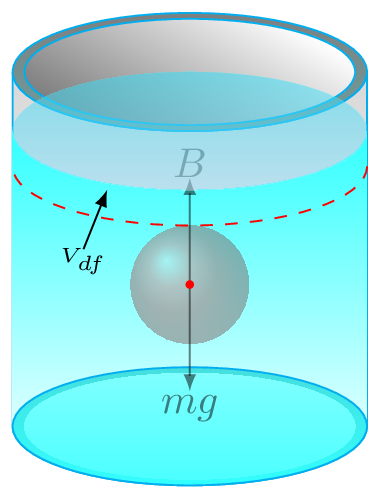Subsection 4.2.1 Archimedes’ Principle
When an object is placed in a fluid it experiences an upthrust force called a buoyant force. It is rising due to changes of pressure inside the fluid. This phenomenon is known as Archimedes’ principle . It states that when a body is fully or partially immersed in a fluid, the fluid exerts an upward force on the body equal to the weight of the liquid displaced. That is, a buoyant force (\(B\)) = weight of a displaced fluid (\(w_{df}\)).
\begin{equation}
B= w_{df} = m_{df}\cdot g = V_{df}\cdot d\cdot g\tag{4.2.5}
\end{equation}
It is the buoyant force due to which your weight feels less in swimming pool. Actually, a buoyant force is the loss of weight of an object in a liquid or fluid. It can also be defined as
\begin{equation}
B= w_{a} -w_{l} \tag{4.2.6}
\end{equation}
Here, \(w_{a}\) is a weight of an object in air and \(w_{l}\) is a weight of an object in liquid. Archimedes’ principle tells whether the object floats or sinks in the fluid. If the weight of the object is greater than the buoyant force, it sinks. If its weight is equal to the buoyant force, it submerges inside the fluid but does not sink. If its weight is less than the buoyant force it floats on the surface of the liquid.

In this case, the volume of displaced liquid is equal to the volume of the submerged portion of the object. On this basis, we can tell that if the density of an object is greater than that of the fluid, it sinks. If object density is equal to the density of the fluid, then the object submerges. If an object’s density is less than the density of the fluid, then the object floats. To make an iron ship not sink in water, it is made with wide surface area and its body is like a hollow shell, so that the density of the entire ship is less than the density of water.
